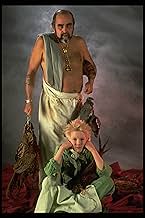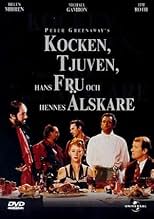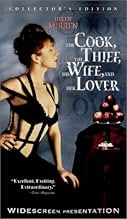Le Cuisinier, le voleur, sa femme et son amant
Original title: The Cook, the Thief, His Wife & Her Lover
At an opulent gourmet restaurant, a woman carries on an affair with deadly consequences.At an opulent gourmet restaurant, a woman carries on an affair with deadly consequences.At an opulent gourmet restaurant, a woman carries on an affair with deadly consequences.
- Awards
- 7 wins & 11 nominations total
Ciarán Hinds
- Cory
- (as Ciaran Hinds)
Roger Ashton-Griffiths
- Turpin
- (as Roger Ashton Griffiths)
- Director
- Writer
- All cast & crew
- Production, box office & more at IMDbPro
Featured reviews
I saw this almost fifteen years ago and I still have crystal clear mental images of some of the scenes. The chef at his table in the kitchen, planning his menu: stunning! Put it in a frame, hang it on the wall. In the restaurant scenes, you feel like you're there at the table as the camera pans, without cuts, from one person to another. Our heroes locked in the truck full of rotting meat: horrible, disgusting, perfect. It's a classic purification ritual and it's literally putrid. Greenaway is a genius. My only criticism is a minor one. There is a full frontal nude scene of the wife and her lover, where he is clearly more "relaxed" than he should have been at that moment. I'm a bit disappointed in Greenaway for not showing him at "attention", as he would have been in real life. But then, I guess he would have been accused of making porn. Whatever. This film is not for everyone. My wife didn't see it. I'm sure she would have hated it if she had. For that matter, I can't actually say I liked it, although I consider it a masterwork. But I'm glad I saw it. I'll probably see it again, but not until I can see it on HDTV. Plain old DVD couldn't possibly do it justice. An amazing movie.
The cruel and sadistic crime boss Albert Spica (Michael Gambon) has dinner every night in his restaurant with his wife Georgina Spica (Helen Mirren) and his gang. Albert abuses of his wife, his gangsters, the chef Richard Borst (Richard Bohringer) and the restaurant employees.
When Georgina meets the gentle bookseller Michael (Alan Howard) in the restaurant, they have a torrid affair in the restroom and in the store, and they are covered by Richard. However the prostitute Pat discloses to Albert that he has been betrayed by Georgina and Albert kills Michael. However Georgina plots revenge against Albert with the support of Richard and the victims of Albert.
"The Cook the Thief His Wife & Her Lover" is one of the most grotesque, eschatological, bizarre and weird films that I have ever seen. But it is also absolutely original and mesmerizing, with intense use of colors, and with the contrast of vulgarity and art. Food, eschatology, sex, cruelty, torture, cannibalism and revenge are entwined along 124 minutes running time. The result is not pleasant and only specific audiences will appreciate this film. Last time I had seen this film was on 08 September 2000 on VHS. My vote is eight.
Title (Brazil): "O Cozinheiro, o Ladrão, Sua Mulher e o Amante" ("The Cook the Thief, His Wife and the Lover")
When Georgina meets the gentle bookseller Michael (Alan Howard) in the restaurant, they have a torrid affair in the restroom and in the store, and they are covered by Richard. However the prostitute Pat discloses to Albert that he has been betrayed by Georgina and Albert kills Michael. However Georgina plots revenge against Albert with the support of Richard and the victims of Albert.
"The Cook the Thief His Wife & Her Lover" is one of the most grotesque, eschatological, bizarre and weird films that I have ever seen. But it is also absolutely original and mesmerizing, with intense use of colors, and with the contrast of vulgarity and art. Food, eschatology, sex, cruelty, torture, cannibalism and revenge are entwined along 124 minutes running time. The result is not pleasant and only specific audiences will appreciate this film. Last time I had seen this film was on 08 September 2000 on VHS. My vote is eight.
Title (Brazil): "O Cozinheiro, o Ladrão, Sua Mulher e o Amante" ("The Cook the Thief, His Wife and the Lover")
I sat transfixed by this film's ability to become increasingly depraved, always without any redeeming quality whatsoever. We would have left except that I became fascinated by the ability of the director and writer to hit bottom and then keep drilling. The story is familiar enough but there are no protagonists. There really are no antagonists either. Just a bunch of people you care nothing about doing things you don't want to know about. If a friend did this stuff to another human and wanted to tell you about it, you would scream for him/her to stop.
To top it off it has a score by Michael Nyman who had just enough talent to write one bad film score and retreads it for every film that a producer is stupid enough to hire him to score.
To top it off it has a score by Michael Nyman who had just enough talent to write one bad film score and retreads it for every film that a producer is stupid enough to hire him to score.
My introduction to Greenaway was `Prospero's Books,' which I rate very highly. I next saw `The Pillow Book,' which also was magic. I now delve into this earlier work, which is before Greenaway became master of overlayed windows. And also before he developed (at least in the two films mentioned) a clean sense of layering allegory.
In this early film the sense of allegory is simplistic, and the notion of narrative is largely abandoned. All in all, this is a cleaner film. Greenaway's fulcrum is the creation of a massive clockworks kitchen with dozens of concurrent, interrelated processes. Everything revolves around this, or more precisely the vision of this. Around this center, we see both vile and sublime forces acting on the kitchen, which is a sort of metalevel over the world from which creation emanates.
I suppose many will remember some of the more disturbing incidental images. Not me. I'll remember that extraordinary kitchen.
In this early film the sense of allegory is simplistic, and the notion of narrative is largely abandoned. All in all, this is a cleaner film. Greenaway's fulcrum is the creation of a massive clockworks kitchen with dozens of concurrent, interrelated processes. Everything revolves around this, or more precisely the vision of this. Around this center, we see both vile and sublime forces acting on the kitchen, which is a sort of metalevel over the world from which creation emanates.
I suppose many will remember some of the more disturbing incidental images. Not me. I'll remember that extraordinary kitchen.
Imagine the universe as a restaurant. The parking lot is the world. The kitchen is purgatory. The ladies's room is heaven. The dining room is hell. Hell is ruled over by Albert Spica, (Satan) excellently played by Michael Gobon. Dante is Michael (Alan Howard) a cataloger of French books. Beatrice, Dante's perfect woman, Georgina Spica (Helen Mirren) who is married to the devil.
In the beginning, the cook (God) in the real world is seen kicked and smeared and fed dog feces by Gabon. He is humiliated and in tears, but He endures and eventually helps to further the love between Howard and MIrren. Sex, in its pure form, is looked at as something sacred. Gabon lords over everyone in his realm with a tyrant's fist, caring nothing about anyone or anything. He wants two three things out of lifesuperiority to all other being, food and sex, while Mirren, as a reluctant Persephone, sneaks off to be with Howard. A couple of times Gabon even finds his way into the sanctity of heaven, but this is only short-lived.
The mood of the film is dark-black, heralded by brilliant reds or greens, and the tenor of an angelic child throughout. Every image is like a painting. Emotions creep in from all directions.
This is a film that would never, no matter what year it was produced, have won an Academy Award. It is too refined, to subtle, too sensual, too intelligent.
Watch it, rent it, buy it. It must be seen.
In the beginning, the cook (God) in the real world is seen kicked and smeared and fed dog feces by Gabon. He is humiliated and in tears, but He endures and eventually helps to further the love between Howard and MIrren. Sex, in its pure form, is looked at as something sacred. Gabon lords over everyone in his realm with a tyrant's fist, caring nothing about anyone or anything. He wants two three things out of lifesuperiority to all other being, food and sex, while Mirren, as a reluctant Persephone, sneaks off to be with Howard. A couple of times Gabon even finds his way into the sanctity of heaven, but this is only short-lived.
The mood of the film is dark-black, heralded by brilliant reds or greens, and the tenor of an angelic child throughout. Every image is like a painting. Emotions creep in from all directions.
This is a film that would never, no matter what year it was produced, have won an Academy Award. It is too refined, to subtle, too sensual, too intelligent.
Watch it, rent it, buy it. It must be seen.
Did you know
- TriviaThe four title characters were named for the actors and actress writer and director Peter Greenaway originally wanted to play them. Richard (The Cook) was for Richard Bohringer, the only one of Greenaway's original choices retained in the final movie. Albert (The Thief) was named after Albert Finney, while Georgina (His Wife) was for Georgina Hale. Michael (The Lover) was named, interestingly enough, for Sir Michael Gambon, who Greenaway eventually re-cast as Albert.
- GoofsWhen Albert (Michael Gambon) goes into the ladies' toilet and starts throwing women out of the cubicles, the second one has, as you would expect, her underwear around her knees. But her skirt rides right up, revealing that she is still wearing her underwear and that the ones below are a prop.
- Crazy creditsClosing credits epilogue: "And a special thanks to those very many people who patiently & repeatedly performed as patients & nurses in the hospital ward, and as diners in the Hollandais Restaurant."
- Alternate versionsAn edited, R-rated version is available on video.
Details
- Release date
- Countries of origin
- Official site
- Languages
- Also known as
- El cocinero, el ladrón, su esposa y su amante
- Filming locations
- Production companies
- See more company credits at IMDbPro
Box office
- Gross US & Canada
- $7,724,701
- Opening weekend US & Canada
- $252,223
- Apr 8, 1990
- Gross worldwide
- $8,527,316
- Runtime
- 2h 4m(124 min)
- Color
- Aspect ratio
- 2.35 : 1
Contribute to this page
Suggest an edit or add missing content






































